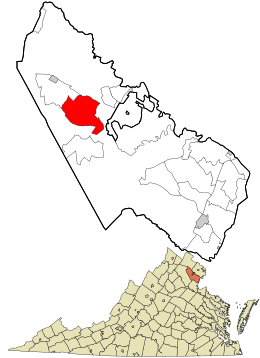Linton Hall, Virginia facts for kids
Quick facts for kids
Linton Hall, Virginia
|
|
|---|---|
|
Census-designated place (CDP)
|
|

Location in Prince William County and the state of Virginia.
|
|
| Country | United States |
| State | Virginia |
| County | Prince William |
| Area | |
| • Total | 8.3 sq mi (21.4 km2) |
| • Land | 8.3 sq mi (21.4 km2) |
| • Water | 0.0 sq mi (0.0 km2) |
| Elevation | 246 ft (75 m) |
| Population
(2020)
|
|
| • Total | 41,754 |
| • Density | 5,031/sq mi (1,951/km2) |
| Time zone | UTC−5 (Eastern (EST)) |
| • Summer (DST) | UTC−4 (EDT) |
| Area code(s) | 571, 703 |
| FIPS code | 51-45957 |
| GNIS feature ID | 1852916 |
Linton Hall is a special kind of community called a census-designated place (CDP) in Prince William County, Virginia, United States. It includes the area known as Bristow. In 2020, about 41,754 people lived here. This was a huge increase from the year 2000!
People living in Linton Hall used to have some of the longest daily travel times to work in the whole country. Between 2005 and 2007, their average one-way trip was over 46 minutes. This was much longer than the national average of about 25 minutes. Local leaders explained that new homes were built quickly, but the roads needed to support them weren't ready yet.
Contents
History of Linton Hall
The name "Linton Hall" comes from the Linton Hall School. This school was started by Benedictine nuns. It was built on land that used to be a large farm called Linton's Ford Plantation.
From Plantation to School
The land for the school was inherited by Sister Mary Baptista. She was the daughter of John Linton, who owned the plantation. When Sister Mary Baptista passed away, the land went to the Benedictine order. They wanted to use it to educate children who didn't have much money. The Benedictine monastery is still a part of the school today.
Growth and Development
Over the past 100 years, the Benedictine nuns sold most of the school's land. They mainly sold it to companies that build homes. This led to the creation of the Braemar subdivision. Braemar is a group of fancy housing areas with a big neighborhood association.
The Linton Family Cemetery
There is an old family cemetery for the Linton family inside the Braemar neighborhood. In 2006, experts checked the site to see if it could be fixed up. The nuns at Linton Hall wanted to keep owning the cemetery. However, many land records were lost during the Civil War. This happened when the Brentsville Courthouse burned down. Because of this, no one officially owns the cemetery today.
Geography of Linton Hall
Linton Hall is located at 38°45′15″N 77°34′50″W / 38.75417°N 77.58056°W.
The United States Census Bureau says that Linton Hall covers about 8.3 square miles (21.4 square kilometers). All of this area is land, with no large bodies of water.
People of Linton Hall
In the year 2000, there were 8,620 people living in Linton Hall. There were 2,733 households, which are groups of people living together. Most of these were families. The population grew a lot by 2010 and even more by 2020.
Who Lives Here?
- Many households (57.3%) had children under 18 living with them.
- Most households (78.7%) were married couples living together.
- The average household had about 3.12 people.
- The average family had about 3.34 people.
Age Groups
The people in Linton Hall are spread across different age groups:
- 35.4% were under 18 years old.
- 46.3% were between 25 and 44 years old. This means many adults in their working years live here.
- The average age was 30 years old.
Income Information
In 2007, the average income for a household in Linton Hall was about $115,581. For families, it was about $122,487. A small number of families (1.9%) and people (2.8%) lived below the poverty line.
See also
 In Spanish: Linton Hall (Virginia) para niños
In Spanish: Linton Hall (Virginia) para niños

